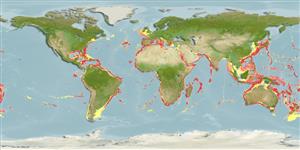Malacostraca |
Decapoda |
Aristeidae
Environment: milieu / climate zone / depth range / distribution range
生態學
底中水層性; 深度上下限 60 - 1300 m (Ref. 97594), usually 250 - 750 m (Ref. 409). ? - 14°C (Ref. 434), preferred 20°C (Ref. 107945); 55°N - 55°S, 180°W - 180°E
Atlantic, the Mediterranean and Indo-Pacific. Tropical to temperate.
Length at first maturity / 大小 / 重量 / 年齡
Maturity: Lm 3.7, range 3 - 4.414 cm Max length : 17.0 cm TL 雄魚/尚未辨別雌雄; (Ref. 104052); 22.5 cm TL (female); 最大體重: 45.90 g (Ref. 126095); 最大體重: 45.90 g; 最大年齡: 8 年 (Ref. 80203)
Deep-water benthopelagic shrimp (Ref. 114287). Common total length: 12 to 16 cm. Minimum common depth from Ref. 8. Usually caught on muddy and sandy bottoms of continental slopes (Ref. 434). Lives on bottom mud (Ref. 8); also on sandy bottoms. Moves to midwater at night (Ref. 409). Carnivorous, feeds mainly on euphausiids and other species of crustaceans, i.e., mainly Natantia sp. (Ref. 434). Has a highly diversified diet (Refs. 97770, 105137), preying on pelagic, benthic and benthopelagic organisms (Ref. 105137); mainly forages on crustaceans and fish. Also scavenges upon carcasses of fish and cephalopods on the bottom (Ref. 97770). Exhibits cannibalism. Values of δ15N ranges from 6.68 and 7.96 in females, and 7.05 and 8.26 in males, with females having higher δ15N with increasing size (Ref. 105135).
Life cycle and mating behavior
成熟度 | 繁殖 | 產卵場 | 卵 | 孕卵數 | 仔魚
Spawning occurs during spring to summer. Females have a life span of 7-8 years while males live for 5-6 years.
主要參考資料
參考文獻 | 合作者 | 合作者
Pérez Farfante, I. and B. Kensley. 1997. (Ref. 75620)
IUCN 瀕危狀態 (Ref. 130435)
CITES狀態 (Ref. 108899)
Not Evaluated
Not Evaluated
對人類具威脅
人類使用
漁業: 商業性
FAO - 漁業: landings | FishSource | 周邊海洋
工具
網路資源
Estimates based on models
Preferred temperature
(Ref.
115969): 5.9 - 15.7, mean 10 (based on 1552 cells).
回復力
高度, 族群倍增時間少於 15個月 (K=0.37-0.96; tm=1.5; tmax=8).
Prior r = 0.77, 95% CL = 0.51 - 1.16, Based on 4 full stock assessments.
瀕危性
Low vulnerability (10 of 100).
Nutrients: Calcium = 109 [35, 184] mg/100g; Iron = 1.59 [1.21, 1.97] mg/100g; Protein = 20.2 [19.2, 21.3] %; Omega3 = 0.285 [0.185, 0.386] g/100g; Selenium = 48.3 [-31.7, 128.3] μg/100g; VitaminA = 0 μg/100g; Zinc = 1.79 [1.17, 2.40] mg/100g (wet weight).
